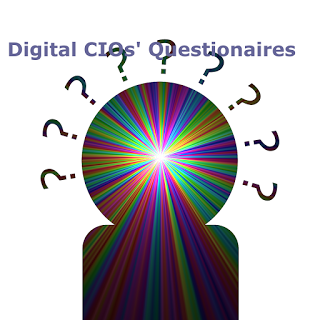Pearl Zhu's Blog, page 1349
April 11, 2016
“CIO Master” Tuning III: Three Stages on the Road for IT to Reach Digital Mastery
 The majority of IT organizations today are still running at the industrial speed, stick at the lower or mid-level of maturity, And IT also is suffered from its reputation as a help desk and cost center. CIOs as IT leaders also face unprecedented pressure to reinvent IT and unleash its full digital potential. What are crucial stages on the road for IT to overcome obstacles, speed up and reach the next level fo digital mastery?
The majority of IT organizations today are still running at the industrial speed, stick at the lower or mid-level of maturity, And IT also is suffered from its reputation as a help desk and cost center. CIOs as IT leaders also face unprecedented pressure to reinvent IT and unleash its full digital potential. What are crucial stages on the road for IT to overcome obstacles, speed up and reach the next level fo digital mastery?
Identify Blind Spot: “Blind Spot” is due to a lack of sufficient resources. Many companies are trying to do more with less. Unfortunately, the IT department seems to be one of the first teams to be impacted by any budget cuts. This results in a team that has to spend all their time for maintenance and keep the lights on, rather than focusing on developing STRATEGIES that advance the business and give them a competitive edge in the marketplace. If IT Departments are going to move in this direction, they MUST alleviate themselves of the mundane, daily tasks that weigh them down. Indeed, there are also blind spots in strategy formulation and execution. IT strategy is an integral component of business strategy, however, in many low-mature organizations, IT strategy is detached from business strategy, and the blind spots will be hidden in three “C”s: Customer, Competitor, Choice, and three “T”s: Threat, Trends, and Truth, etc. Business Fails IT, just like IT fails business: Many organizations are still running at industrial speed -with bureaucratic culture and hierarchical decision-making scenario, at organizations with lower level of maturity, business is the sum of pieces than a holistic whole, functional silos compete for resources, rather than work collaboratively & seamlessly to optimize business. Such silo culture will create numerous blind spot in resources, process, capacity, and capability. One possible cause of the blind spot is the fact that many IT organizations can neither sufficiently measure the value they provide to their organizations nor, as a consequence, articulate their value to the organization in a language the organization understands.
Discover the niche point: Digital is the age of customers. Assuming the company has a great product, creating meaningful, relevant, and compelling differentiation in the mind of customers is the challenge. From a customer perspective, if the business is not different, you are a commodity, either for IT or the business as a whole. This is the foundation in which brands are built. This is the strategy that helps to protect the brand and products from the low-priced competition. Running a niche player IT has to be customer-centric as well, IT has both internal users and end customers. Running a niche player IT means you need to build a set of core capabilities which underpin strategy implementation and bring business advantage. The business capabilities cut across all functional pillars, they are fundamental building blocks for digital transformation. The capability is a useful composite concept that is fairly specific in its bounds, and can be used as an analysis tool. Processes underpin business capabilities; and culture nurtures capability coherence. From leadership perspective, most of the executive peers do not have a deep understanding of technology or business processes while effective CIOs have to know both the business and the technology side of things. You cannot know only one piece of the equation. It means the CIO’s niche leadership is based on the strategic mindset, multifaceted knowledge & business understanding, anticipated leadership styles, and further, CIOs need to present high “PI” -the Paradoxical Intelligence, because CIOs need to deal with constant ambiguity, they naturally gravitate to a leadership role when things are unknown, things will change, technology is involved, a tough problem has to be solved, etc
 IT acceleration: At the industrial age, IT had the reputation as a cost center and IT was not fast enough to respond to change. Ironically, often technology is the disruptive force behind digital transformation, to speed up, IT needs to fine tuning processes, building the right set of capabilities to improve its agility. IT acceleration also means to speed up the organizational vehicle as well. IT is the steward of the business’s information system, it is also in the unique position to oversight the business landscape horizontally. IT should plays an important role in building up agile enterprises which can succeed in combining two distinct but interconnected elements: strategic responsiveness and organizational flexibility, with the combination of an innovative culture that promotes responsiveness throughout the company. To speed up, IT needs to run as an innovation engine of the business. IT should proactively generate ideas and then work with business partners to take those ideas forward. IT plays an innovation role as more of a proactive influencer. IT can drive all sort of innovation, proactively pushing ideas on how to leverage technology to drive revenue growth, increase business productivity, flexibility and speed up for changes.
IT acceleration: At the industrial age, IT had the reputation as a cost center and IT was not fast enough to respond to change. Ironically, often technology is the disruptive force behind digital transformation, to speed up, IT needs to fine tuning processes, building the right set of capabilities to improve its agility. IT acceleration also means to speed up the organizational vehicle as well. IT is the steward of the business’s information system, it is also in the unique position to oversight the business landscape horizontally. IT should plays an important role in building up agile enterprises which can succeed in combining two distinct but interconnected elements: strategic responsiveness and organizational flexibility, with the combination of an innovative culture that promotes responsiveness throughout the company. To speed up, IT needs to run as an innovation engine of the business. IT should proactively generate ideas and then work with business partners to take those ideas forward. IT plays an innovation role as more of a proactive influencer. IT can drive all sort of innovation, proactively pushing ideas on how to leverage technology to drive revenue growth, increase business productivity, flexibility and speed up for changes.
To become value added and master digital transformation, IT need to be acutely in tune with the business. IT needs to be a proactive business problem solver with setting priority right, IT and business need to work collaboratively to identify blind spots and close management gaps, to build differentiated capabilities and gain competitive advantages for the business’s growth and prosperity.
CIO Master Order Link on AmazonCIO Master Ordre Link on Barner & NobleCIO Master Order Link On IBooks
“CIO Master” Book Preview Quote Collection III“CIO Master” Book Preview Quote Collection II“CIO Master” Book Preview Quote Collection I, Slideshare Presentation“CIO Master” Book Preview Conclusion Running IT as Digital Transformer“CIO Master” Book Preview: Chapter 9 IT Agility“CIO Master” Book Preview: Chapter 8 Three "P"s in Running Digital IT“CIO Master” Book Preview: Chapter 7 IT Innovation Management“CIO Master” Book Preview: Chapter 6 Digital Strategy-Execution Continuum"CIO Master” Book Preview: Chapter 5 Thirteen Digital Flavored IT“CIO Master” Book Preview: Chapter 4 CIO as Talent Master Introduction“CIO Master” Book Preview: Chapter 3 “CIOs as Change Agent” Introduction“CIO Master” Book Preview: Chapter 2 “CIOs as Digital Visionary” Introduction“CIO Master” Book Preview: Chapter 1 “Twelve Digital CIO Personas” Introduction"CIO Master - Unleash the Digital Potential of IT" Introduction"CIO Master - Unleash the Digital Potential of IT" Book Preview
Follow us at: @Pearl_Zhu
Published on April 11, 2016 23:02
April 10, 2016
Talent Management Monthly Brief: See Through Talent from Different Angles VI Apr. 2016

People are always the most invaluable asset in businesses. “Hiring the right person to the right position at the right time,” is the mantra of many forward-thinking organizations. The question is how would you define the right people? How do you define wrong, average, mediocre, good, great or extraordinary person? Or put simply, for what should they be right? Traditional Performance Management focusing on measuring what an employee does (mainly being told to do) in a quantitative way is not sufficient to identify high performance or high potential, should we see through talent from different angles?
See Through Talent from Different Angles Three Questions to Assess a Person’s “Resourcefulness” We are moving from the age of information scarcity to the Digital Era of data abundance, from building a workforce with understanding of the existing knowledge to grooming an innovative team who can co-create and share new knowledge; from tolerating people having a “graduate attitude” after receiving certain years of formal education to empowering the lifetime learners who continuously learn with the hybrid digital learning style. Digital professionals need to be intellectually curious, resourceful and learning agile. What are specific questions to ask for assessing a person’s “resourcefulness,” and how can digital professionals speed up to ride above the learning curve, and climb the information pyramid (information-knowledge-insight-wisdom) more effortlessly?
Three Questions to assess a Person’s “EQ” Emotional Intelligence is the ability to identify and manage your own emotions and the emotions of others.A mature reaction to a given situation will determine your level of Emotional Intelligence (EQ). Higher EQ helps you have an open mind, minimize biases, be cautiously optimistic, be an effective listener and be more creative. More specifically, how to assess a person’s “EQ” level?Three Questions to Assess a Person’s Ingenuity: Generally speaking, creativity is an innate process to create novel ideas; ingenuity is the ability to solve difficult problems, often in the original and creative way. It is the qualification to be creative, insightful and inventive. Some say ingenuity is the distant cousin of creativity, ingenuity often demands creativity as a mixed ingredient for puzzle-solving or invention. Ingenuity is increasingly important because the business world becomes overly complex and hyper-connected, so which questions to ask for assessing a person’s ingenuity?
Three Questions to Assess a Person’s “Judgmental Intelligence”: Both businesses and the world become hyperconnected and overly complex, either for leaders or digital professionals today, to survive and thrive in such a “VUCA” new normal, you need to have multidimensional intelligence such as IQ, EQ, SQ (Strategy Intelligence), CQ (Creativity Intelligence) and JQ (Judgmental Intelligence) etc., for both doing the right things and doing them right, making sound judgment and bringing the wisdom to the workplace. Which questions should you ask to assess a person’s “Judgment Intelligence” though?
 Three Questions to Assess a Person’s Gravitas? Gravitas can be defined to mean of substance, seriousness, or dignified demeanor. And it is important to both those who aspire to lead and those who allow others to lead them. Individuals who possess gravitas work to maintain decorum most conducive to achieving the desired results regardless of the situation at hand. They also present Emotional Excellence to make positive leadership influence. It becomes a significant leadership and professional quality. More specifically, what is Gravitas all about, and how to assess a person’s gravitas?The “Future of CIO” Blog has reached 1.3+million page views with about #2500+ blog posting in 59+ different categories of leadership, management, strategy, digitalization, change/talent, etc. blog posting. The content richness is not for its own sake, but to convey the vision and share the wisdom, to inspire critical thinking and spur healthy debates. Blogging is not about writing, but about thinking and innovating the new ideas; it’s not just about WHAT to say, but about WHY to say, and HOW to say it. It reflects the color and shade of your thought patterns, and it indicates the peaks and curves of your thinking waves. Unlike pure entertainment, quality and professional content takes time for digesting, contemplation and engaging, and therefore, it takes the time to attract the "hungry minds" and the "deep souls." It’s the journey to amplify diverse voices and deepen digital footprints, and it's the way to harness your innovative spirit.
Three Questions to Assess a Person’s Gravitas? Gravitas can be defined to mean of substance, seriousness, or dignified demeanor. And it is important to both those who aspire to lead and those who allow others to lead them. Individuals who possess gravitas work to maintain decorum most conducive to achieving the desired results regardless of the situation at hand. They also present Emotional Excellence to make positive leadership influence. It becomes a significant leadership and professional quality. More specifically, what is Gravitas all about, and how to assess a person’s gravitas?The “Future of CIO” Blog has reached 1.3+million page views with about #2500+ blog posting in 59+ different categories of leadership, management, strategy, digitalization, change/talent, etc. blog posting. The content richness is not for its own sake, but to convey the vision and share the wisdom, to inspire critical thinking and spur healthy debates. Blogging is not about writing, but about thinking and innovating the new ideas; it’s not just about WHAT to say, but about WHY to say, and HOW to say it. It reflects the color and shade of your thought patterns, and it indicates the peaks and curves of your thinking waves. Unlike pure entertainment, quality and professional content takes time for digesting, contemplation and engaging, and therefore, it takes the time to attract the "hungry minds" and the "deep souls." It’s the journey to amplify diverse voices and deepen digital footprints, and it's the way to harness your innovative spirit.See through talent from different angles Mar. 2016See through talent from different angles Feb. 2016See through talent from different angles Jan. 2016See through talent from different angles Dec. 2015See through talent from different angles Nov. 2015Follow us at: @Pearl_Zhu
Published on April 10, 2016 23:50
“CIO Master” Tuning II Three Debates in IT Talent Management
With the increasing speed of change and digital dynamic, IT talent management will see the urgency of being both innovative and analytics-based, to hire the right people and keep them "digital fit."
 People are always the most invaluable asset in businesses. But how can you hire the right people who possess the right mind with knowledge, skills, abilities and behaviors necessary to move your business in the direction? How can you keep the talented employees engaged and help to realize the business vision and values of the organization, so they are not just running the business, but keep innovating and transforming the business for the long-term prosperity? Due to the change and complexity nature of IT, what are the hot debates to spark brainstorming for IT talent management and how to innovate people management and performance management effectively?
People are always the most invaluable asset in businesses. But how can you hire the right people who possess the right mind with knowledge, skills, abilities and behaviors necessary to move your business in the direction? How can you keep the talented employees engaged and help to realize the business vision and values of the organization, so they are not just running the business, but keep innovating and transforming the business for the long-term prosperity? Due to the change and complexity nature of IT, what are the hot debates to spark brainstorming for IT talent management and how to innovate people management and performance management effectively?
Is IT skills gap fact or fiction? There is always a debate regarding IT talent supply and demand, does IT skills gap really exist? If so, what are the root causes of the gaps, and how to close them? With pervasive IT, new technologies and products, the gaps do exist at different levels, from cognition to culture, from communication to innovation, from skills to capabilities. Mainly IT needs both specialized generalists who understand both business and technology, and have the right mix of technical skills and business acumen for solving the right problems and solving them right, as well as dedicated IT specialists who can handle the heads down technical tasks efficiently. IT needs to strike the right balance of the “old way” doing things to keep the lights on, as well as provide innovative solutions to do things differently, drive business growth and gain competitive advantage. IT leaders should always ask themselves whether the workplace is healthy enough to attract and retain the best and brightest. Either the cognitive gap, skill gap, gender gap, or generation gap, what are the root causes behind it? Overall, technology tends to be more dynamic in a company as well as across the industry, the key is to recognize that they both change and demand everyone to continuously maintain and grow their expertise or skills to keep 'digital fit.' IT or the organization as a whole needs to take a set of digital practices for talent development and management innovation.

What differentiates top IT performers from the norm? Though every position is different, and every business and industry has its own criteria and focuses on talent measurement. But overall speaking, what personality and behavioral characteristics are displayed by top IT performers? With the pace of change speeding up, are those key performance indicators changing as well? Top IT performers, just like top performers in any other discipline, seek a balance of their influence and add value to the business through their specific set of knowledge and expertise. High-performers believe the whole is better than the sum of pieces, so they focus on the practical application of the knowledge to achieve the objectives of the organization. The top IT performers also are those who keep themselves updated with the latest technologies. It is particularly critical for IT professionals to have "changeability" and learning agility because technology is often the disruptive force behind the business transformation. Hence, IT talent need to be the change agent and continue to update their knowledge and become more adaptive, creative, and flexible, and they are always on the lookout for ways to improve.
 How to attract, develop, and retain the best IT talent? Talent Management is perhaps one of the most critical practices in business today, developing and retaining IT talent is even more challenging due to the variety of gaps existing between business and IT, changing nature of technology and smartness of IT professionals. Recognizing that talent is people and people have ambition and drive, it is important to foster close ties between the IT team and the business such that IT team members really understand how critical their role is and get regular feedback on how well they are doing. Keep people interested and give them challenges and the sense of purposes, so they will find the sense of relevance and satisfaction. Rotate IT staff across teams to give them exposure to different technologies and business applications, change and transformation agents look for growth opportunities because they offer challenges and accomplishment then it comes to fruition. High potential IT professionals have the strong “sense and sensitivity,” only insightful management with solid judgment can manage them effectively.
How to attract, develop, and retain the best IT talent? Talent Management is perhaps one of the most critical practices in business today, developing and retaining IT talent is even more challenging due to the variety of gaps existing between business and IT, changing nature of technology and smartness of IT professionals. Recognizing that talent is people and people have ambition and drive, it is important to foster close ties between the IT team and the business such that IT team members really understand how critical their role is and get regular feedback on how well they are doing. Keep people interested and give them challenges and the sense of purposes, so they will find the sense of relevance and satisfaction. Rotate IT staff across teams to give them exposure to different technologies and business applications, change and transformation agents look for growth opportunities because they offer challenges and accomplishment then it comes to fruition. High potential IT professionals have the strong “sense and sensitivity,” only insightful management with solid judgment can manage them effectively.
With the increasing speed of change and digital dynamic, IT talent management will see the urgency of being both innovative and analytics-based, set the right course and make a good alignment of talent management, culture management, and performance management, keep all staff working harmoniously to achieve business goals, at the same time inspire individuals to exceed their career goals, discover purpose and reach the high level of Maslow's pyramid. It’s a win-win for both individuals and the organization.
CIO Master Order Link on AmazonCIO Master Ordre Link on Barner & NobleCIO Master Order Link On IBooks
“CIO Master” Book Preview Quote Collection III“CIO Master” Book Preview Quote Collection II“CIO Master” Book Preview Quote Collection I, Slideshare Presentation“CIO Master” Book Preview Conclusion Running IT as Digital Transformer“CIO Master” Book Preview: Chapter 9 IT Agility“CIO Master” Book Preview: Chapter 8 Three "P"s in Running Digital IT“CIO Master” Book Preview: Chapter 7 IT Innovation Management“CIO Master” Book Preview: Chapter 6 Digital Strategy-Execution Continuum"CIO Master” Book Preview: Chapter 5 Thirteen Digital Flavored IT“CIO Master” Book Preview: Chapter 4 CIO as Talent Master Introduction“CIO Master” Book Preview: Chapter 3 “CIOs as Change Agent” Introduction“CIO Master” Book Preview: Chapter 2 “CIOs as Digital Visionary” Introduction“CIO Master” Book Preview: Chapter 1 “Twelve Digital CIO Personas” Introduction"CIO Master - Unleash the Digital Potential of IT" Introduction"CIO Master - Unleash the Digital Potential of IT" Book Preview
Follow us at: @Pearl_Zhu
 People are always the most invaluable asset in businesses. But how can you hire the right people who possess the right mind with knowledge, skills, abilities and behaviors necessary to move your business in the direction? How can you keep the talented employees engaged and help to realize the business vision and values of the organization, so they are not just running the business, but keep innovating and transforming the business for the long-term prosperity? Due to the change and complexity nature of IT, what are the hot debates to spark brainstorming for IT talent management and how to innovate people management and performance management effectively?
People are always the most invaluable asset in businesses. But how can you hire the right people who possess the right mind with knowledge, skills, abilities and behaviors necessary to move your business in the direction? How can you keep the talented employees engaged and help to realize the business vision and values of the organization, so they are not just running the business, but keep innovating and transforming the business for the long-term prosperity? Due to the change and complexity nature of IT, what are the hot debates to spark brainstorming for IT talent management and how to innovate people management and performance management effectively?Is IT skills gap fact or fiction? There is always a debate regarding IT talent supply and demand, does IT skills gap really exist? If so, what are the root causes of the gaps, and how to close them? With pervasive IT, new technologies and products, the gaps do exist at different levels, from cognition to culture, from communication to innovation, from skills to capabilities. Mainly IT needs both specialized generalists who understand both business and technology, and have the right mix of technical skills and business acumen for solving the right problems and solving them right, as well as dedicated IT specialists who can handle the heads down technical tasks efficiently. IT needs to strike the right balance of the “old way” doing things to keep the lights on, as well as provide innovative solutions to do things differently, drive business growth and gain competitive advantage. IT leaders should always ask themselves whether the workplace is healthy enough to attract and retain the best and brightest. Either the cognitive gap, skill gap, gender gap, or generation gap, what are the root causes behind it? Overall, technology tends to be more dynamic in a company as well as across the industry, the key is to recognize that they both change and demand everyone to continuously maintain and grow their expertise or skills to keep 'digital fit.' IT or the organization as a whole needs to take a set of digital practices for talent development and management innovation.

What differentiates top IT performers from the norm? Though every position is different, and every business and industry has its own criteria and focuses on talent measurement. But overall speaking, what personality and behavioral characteristics are displayed by top IT performers? With the pace of change speeding up, are those key performance indicators changing as well? Top IT performers, just like top performers in any other discipline, seek a balance of their influence and add value to the business through their specific set of knowledge and expertise. High-performers believe the whole is better than the sum of pieces, so they focus on the practical application of the knowledge to achieve the objectives of the organization. The top IT performers also are those who keep themselves updated with the latest technologies. It is particularly critical for IT professionals to have "changeability" and learning agility because technology is often the disruptive force behind the business transformation. Hence, IT talent need to be the change agent and continue to update their knowledge and become more adaptive, creative, and flexible, and they are always on the lookout for ways to improve.
 How to attract, develop, and retain the best IT talent? Talent Management is perhaps one of the most critical practices in business today, developing and retaining IT talent is even more challenging due to the variety of gaps existing between business and IT, changing nature of technology and smartness of IT professionals. Recognizing that talent is people and people have ambition and drive, it is important to foster close ties between the IT team and the business such that IT team members really understand how critical their role is and get regular feedback on how well they are doing. Keep people interested and give them challenges and the sense of purposes, so they will find the sense of relevance and satisfaction. Rotate IT staff across teams to give them exposure to different technologies and business applications, change and transformation agents look for growth opportunities because they offer challenges and accomplishment then it comes to fruition. High potential IT professionals have the strong “sense and sensitivity,” only insightful management with solid judgment can manage them effectively.
How to attract, develop, and retain the best IT talent? Talent Management is perhaps one of the most critical practices in business today, developing and retaining IT talent is even more challenging due to the variety of gaps existing between business and IT, changing nature of technology and smartness of IT professionals. Recognizing that talent is people and people have ambition and drive, it is important to foster close ties between the IT team and the business such that IT team members really understand how critical their role is and get regular feedback on how well they are doing. Keep people interested and give them challenges and the sense of purposes, so they will find the sense of relevance and satisfaction. Rotate IT staff across teams to give them exposure to different technologies and business applications, change and transformation agents look for growth opportunities because they offer challenges and accomplishment then it comes to fruition. High potential IT professionals have the strong “sense and sensitivity,” only insightful management with solid judgment can manage them effectively.
With the increasing speed of change and digital dynamic, IT talent management will see the urgency of being both innovative and analytics-based, set the right course and make a good alignment of talent management, culture management, and performance management, keep all staff working harmoniously to achieve business goals, at the same time inspire individuals to exceed their career goals, discover purpose and reach the high level of Maslow's pyramid. It’s a win-win for both individuals and the organization.
CIO Master Order Link on AmazonCIO Master Ordre Link on Barner & NobleCIO Master Order Link On IBooks
“CIO Master” Book Preview Quote Collection III“CIO Master” Book Preview Quote Collection II“CIO Master” Book Preview Quote Collection I, Slideshare Presentation“CIO Master” Book Preview Conclusion Running IT as Digital Transformer“CIO Master” Book Preview: Chapter 9 IT Agility“CIO Master” Book Preview: Chapter 8 Three "P"s in Running Digital IT“CIO Master” Book Preview: Chapter 7 IT Innovation Management“CIO Master” Book Preview: Chapter 6 Digital Strategy-Execution Continuum"CIO Master” Book Preview: Chapter 5 Thirteen Digital Flavored IT“CIO Master” Book Preview: Chapter 4 CIO as Talent Master Introduction“CIO Master” Book Preview: Chapter 3 “CIOs as Change Agent” Introduction“CIO Master” Book Preview: Chapter 2 “CIOs as Digital Visionary” Introduction“CIO Master” Book Preview: Chapter 1 “Twelve Digital CIO Personas” Introduction"CIO Master - Unleash the Digital Potential of IT" Introduction"CIO Master - Unleash the Digital Potential of IT" Book Preview
Follow us at: @Pearl_Zhu
Published on April 10, 2016 23:42
“CIO Master” Tuning II Three Debates in IT Talent Managemen

People are always the most invaluable asset in businesses. But how can you hire the right people who possess the right mind with knowledge, skills, abilities and behaviors necessary to move your business in the direction? How can you keep the talented employees engaged and help to realize the business vision and values of the organization, so they are not just running the business, but keep innovating and transforming the business for the long-term prosperity? Due to the change and complexity nature of IT, what are the hot debates to spark brainstorming in IT talent management and how to innovate people management and performance management effectively?
Is IT skills gap fact or fiction? There is always a debate regarding IT talent supply and demand, does IT skills gap really exist? If so, what are the root causes of the gaps, and how to close it? With pervasive IT, new technologies and products, the gaps do exist. Mainly IT needs both specialized generalists who understand both business and technology, and have the right mix of technical skills and business acumen for solving the right problems and solving them right, as well as dedicated IT specialist who can handle the heads down technical tasks efficiently. IT needs to strike the right balance of the “old way” doing things to keep the lights on, as well as provide innovative solutions to do things differently, drive business growth and gain competitive advantage. IT leaders should always ask themselves whether the workplace is healthy enough to attract the best and brightest. Either the cognitive gap, skill gap or generation gap, what are the root causes behind it? Overall, technology tends to be more dynamic in a company as well as across the industry, the key is to recognize that they both change and demand everyone to continuously maintain and grow their expertise or skills to keep digital fit. IT or the organization as a whole needs to take a set of digital practices for talent development and management.
What differentiates top IT performers from the norm? Though every position is different, and every business and industry has its own criteria and focuses on talent measurement. But overall speaking, what personality and behavioral characteristics are displayed by top IT performers With the pace of change speeding up, are those key performance indicators changing? Top IT performers, just like top performers in any other discipline, seek a balance of their influence and add value to the business through their specific set of knowledge and expertise. High-performers believe the whole is better than the sum of pieces, so they focus on the practical application of the knowledge to achieve the objectives of the organization. The top IT performers also are those who keep themselves updated with the latest technologies. It is particularly critical for IT talent because technology is often the disruptive force behind business changes, hence, IT talent need to be the change agent and continue to update their knowledge and become more adaptive, learning agile and flexible, and they are always on the lookout for ways to improve.
 How to attract, develop, and retain the best IT talent? Talent Management is perhaps one of the most critical practices in business today, developing and retaining IT talent is even more challenging due to the variety of gaps existing between business and IT, changing nature of technology and smartness of IT professionals. Recognizing that talent is people and people have ambition and drive, it is important to foster close ties between the IT team and the business such that IT team members really understand how critical their role is and get regular feedback on how well they are doing. Keep people interested and give them challenges and the sense of purposes, so they will find the sense of relevance and satisfaction. Rotate IT staff across teams to give them exposure to different technologies and business applications, change and transformation agents look for growth opportunities because they offer challenges and accomplishment then it comes to fruition. IT professionals have the strong “sense and sensitivity,” only insightful management with solid judgment can manage them effectively.
How to attract, develop, and retain the best IT talent? Talent Management is perhaps one of the most critical practices in business today, developing and retaining IT talent is even more challenging due to the variety of gaps existing between business and IT, changing nature of technology and smartness of IT professionals. Recognizing that talent is people and people have ambition and drive, it is important to foster close ties between the IT team and the business such that IT team members really understand how critical their role is and get regular feedback on how well they are doing. Keep people interested and give them challenges and the sense of purposes, so they will find the sense of relevance and satisfaction. Rotate IT staff across teams to give them exposure to different technologies and business applications, change and transformation agents look for growth opportunities because they offer challenges and accomplishment then it comes to fruition. IT professionals have the strong “sense and sensitivity,” only insightful management with solid judgment can manage them effectively.
With increasing speed of change and digital dynamic, talent management will see the urgency of being both innovative and analytics-based, set the right course and make a good alignment of talent management, culture management and performance management, keep all staff working harmoniously to achieve business goals, at the same time push individuals to exceed their career goals. It’s a win-win for both individuals and the organization.
CIO Master Order Link on AmazonCIO Master Ordre Link on Barner & NobleCIO Master Order Link On IBooks
“CIO Master” Book Preview Quote Collection III“CIO Master” Book Preview Quote Collection II“CIO Master” Book Preview Quote Collection I, Slideshare Presentation“CIO Master” Book Preview Conclusion Running IT as Digital Transformer“CIO Master” Book Preview: Chapter 9 IT Agility“CIO Master” Book Preview: Chapter 8 Three "P"s in Running Digital IT“CIO Master” Book Preview: Chapter 7 IT Innovation Management“CIO Master” Book Preview: Chapter 6 Digital Strategy-Execution Continuum"CIO Master” Book Preview: Chapter 5 Thirteen Digital Flavored IT“CIO Master” Book Preview: Chapter 4 CIO as Talent Master Introduction“CIO Master” Book Preview: Chapter 3 “CIOs as Change Agent” Introduction“CIO Master” Book Preview: Chapter 2 “CIOs as Digital Visionary” Introduction“CIO Master” Book Preview: Chapter 1 “Twelve Digital CIO Personas” Introduction"CIO Master - Unleash the Digital Potential of IT" Introduction"CIO Master - Unleash the Digital Potential of IT" Book Preview
Follow us at: @Pearl_Zhu
Published on April 10, 2016 23:42
April 9, 2016
The Book “CIO Master” Quote Collection (Part III)
Digital CIOs Rise for Change!
 The purpose of CIO Master - Unleash the Digital Potential of IT is to provide guidelines for building a framework to run a highly effective, highly innovative and highly mature digital IT organization. Also, it provides the principles to reinvent CIO leadership via practicing multitudes of digital influence. Rebrand digital CIOs with multiple personas Reinvent IT to unleash its full digital potentialReenergize change as an ongoing digital capabilityRefine talent management to bridge IT skills gapRemaster multidimensional IT to create multi-level business valueRenovate strategy execution continuum to improve effectivenessReimagine IT as an innovation engine to catalyze business growth Reshape IT via leveraging “3P”s: Principle, Portfolio, PerformanceRetool IT agility to adapt to changes
The purpose of CIO Master - Unleash the Digital Potential of IT is to provide guidelines for building a framework to run a highly effective, highly innovative and highly mature digital IT organization. Also, it provides the principles to reinvent CIO leadership via practicing multitudes of digital influence. Rebrand digital CIOs with multiple personas Reinvent IT to unleash its full digital potentialReenergize change as an ongoing digital capabilityRefine talent management to bridge IT skills gapRemaster multidimensional IT to create multi-level business valueRenovate strategy execution continuum to improve effectivenessReimagine IT as an innovation engine to catalyze business growth Reshape IT via leveraging “3P”s: Principle, Portfolio, PerformanceRetool IT agility to adapt to changes
Digital IT Management Quotes
 Innovation per se is like composing a symphony, a lot of planning, but the music will come from the musicians, not the conductor.
Innovation per se is like composing a symphony, a lot of planning, but the music will come from the musicians, not the conductor.
Innovation is the specific phenomenon and strategic imperative of the knowledge based economy.
Bridging innovation gaps is a strategic imperative for business execution.
The customer is the center of innovation management. Innovation has to result in something which leads us to a better state than where we are today.
Creativity is the core of what makes IT strategic in any company.
IT agility is a mentality, culture, process, and perspective.
The intersection of information, technology, and people is where innovation happens.
Guiding IT principles let the organization know what to expect when dealing with IT.
Principles are statements of values.
KPIs need to have both high impact and high information context. IT projects are business projects. IT project priority should reflect the business priority.
Agility within and of itself is a strategy.
Agile is better at adapting to changes and ensuring quality.
Agile is more a “direction,” than an “end.”
The overall organizational health needs to be measured via culture readiness, business agility, and customer centricity, etc.
The overall goal of adopting a more “Agile” approach is “resilience,” in essence.
Agile is about doing the right thing before doing it right.
Follow us at: @Pearl_Zhu
 The purpose of CIO Master - Unleash the Digital Potential of IT is to provide guidelines for building a framework to run a highly effective, highly innovative and highly mature digital IT organization. Also, it provides the principles to reinvent CIO leadership via practicing multitudes of digital influence. Rebrand digital CIOs with multiple personas Reinvent IT to unleash its full digital potentialReenergize change as an ongoing digital capabilityRefine talent management to bridge IT skills gapRemaster multidimensional IT to create multi-level business valueRenovate strategy execution continuum to improve effectivenessReimagine IT as an innovation engine to catalyze business growth Reshape IT via leveraging “3P”s: Principle, Portfolio, PerformanceRetool IT agility to adapt to changes
The purpose of CIO Master - Unleash the Digital Potential of IT is to provide guidelines for building a framework to run a highly effective, highly innovative and highly mature digital IT organization. Also, it provides the principles to reinvent CIO leadership via practicing multitudes of digital influence. Rebrand digital CIOs with multiple personas Reinvent IT to unleash its full digital potentialReenergize change as an ongoing digital capabilityRefine talent management to bridge IT skills gapRemaster multidimensional IT to create multi-level business valueRenovate strategy execution continuum to improve effectivenessReimagine IT as an innovation engine to catalyze business growth Reshape IT via leveraging “3P”s: Principle, Portfolio, PerformanceRetool IT agility to adapt to changes
Digital IT Management Quotes
 Innovation per se is like composing a symphony, a lot of planning, but the music will come from the musicians, not the conductor.
Innovation per se is like composing a symphony, a lot of planning, but the music will come from the musicians, not the conductor.
Innovation is the specific phenomenon and strategic imperative of the knowledge based economy.
Bridging innovation gaps is a strategic imperative for business execution.
The customer is the center of innovation management. Innovation has to result in something which leads us to a better state than where we are today.
Creativity is the core of what makes IT strategic in any company.
IT agility is a mentality, culture, process, and perspective.
The intersection of information, technology, and people is where innovation happens.
Guiding IT principles let the organization know what to expect when dealing with IT.
Principles are statements of values.
KPIs need to have both high impact and high information context. IT projects are business projects. IT project priority should reflect the business priority.
Agility within and of itself is a strategy.
Agile is better at adapting to changes and ensuring quality.
Agile is more a “direction,” than an “end.”
The overall organizational health needs to be measured via culture readiness, business agility, and customer centricity, etc.
The overall goal of adopting a more “Agile” approach is “resilience,” in essence.
Agile is about doing the right thing before doing it right.
Follow us at: @Pearl_Zhu
Published on April 09, 2016 23:27
To Celebrate 2700th Blog Posting: The Multitude of Creative Leadership
 Digital is the age of innovation. Creativity matters more than ever because businesses and the world today become over-complex with accelerated changes. The more "creative leaders," we have, the better for the world. Creative leadership is the unique combination of leadership mindset and behaviors that are futuristic and forward thinking, develops and achieves high quality and meaningful results over a sustained period of time. By etymology, "innovare" signifies "to germinate seeds," knowing that, go ahead and innovate by inventing your future, and the one of your company’s. Creative leadership can be described as "Adaptability meets Agility.” Creativity has many faces, and creative leadership is multitude to manage innovation in an effective way.
Digital is the age of innovation. Creativity matters more than ever because businesses and the world today become over-complex with accelerated changes. The more "creative leaders," we have, the better for the world. Creative leadership is the unique combination of leadership mindset and behaviors that are futuristic and forward thinking, develops and achieves high quality and meaningful results over a sustained period of time. By etymology, "innovare" signifies "to germinate seeds," knowing that, go ahead and innovate by inventing your future, and the one of your company’s. Creative leadership can be described as "Adaptability meets Agility.” Creativity has many faces, and creative leadership is multitude to manage innovation in an effective way.
Innovation Paradox: Business innovation often has the characteristic of paradox. The paradox is “a situation, person, or thing that combines contradictory features or qualities.” For example, in business, complexity both drives innovation and also hinders it. When a business becomes overly complex and people get frustrated and annoyed by not being able to accomplish things easily, this drives the search for simpler concepts and methods, which is the need to take the innovative initiative. Also, over-complexity in a business may be hiding simple and innovative ways to achieve things because the people involved just don't get the time to step back from the complexity and hence, they continue to follow the old routine to do the things, lack of the out of box creativity. The paradox is the result of two opposing truths existing side by side, which can be both right. From business perspective, on one side, overly focus on efficiency could limit the creativity potential of the business due to the limited resources invested on innovation, but improving business efficiency is always one of an important aspect to improve business maturity. Hence, efficiency and innovation just have to learn to live and function together. The greater the efficiency of an organization, the greater the need is for creativity to maintain high performance in the long run. Efficiency will extract the maximum benefit from a new idea. If an organization is inefficient, it will be inefficient with new ideas as well. Many process innovations will be concerned with increasing and optimizing efficiency and maintaining existing skills and linkages. Same as the standardization vs creativity, standardization is inside-the-box, and innovation is outside-the-box. Hence, organizations indeed need both, and in fact, cannot realistically exist without a healthy leverage of both.
Innovation balance: An innovative leader must walk the tightrope between diplomat and maverick: There are multitude of factors to spark creativity. On one hand, he/she will get faster results by respecting people, getting the best effort from the people. Listening and orchestrating as fast as possible. On the other hand, to deliver the innovation on time, he/she must be willing to take risks, and jump through some hoops. Knowing that success will reward and failure will punish. You cannot make omelets without breaking some eggs.Walking that tightrope makes the innovation leader a likable acrobat; a true artist; in short, an innovation leader with the right balance. Innovation is about thinking differently, acting differently, delivering differently, adding value differently from the status quo. Therefore, it’s also important to build an innovative team with the right balance of skills, experience, cultural heritage, ability to analyze/self-reflect, sensitivity to social judgment/ridicule, habituation, courage, strategic thinking, etc. Though creativity needs a type of free thinking, creativity with limited resources and a specific goal seems to need the use of more methodical techniques for releasing it, a more rigorous methodology may be demanded by creative environments that need to deliver consistent, frequent results under pressure and manage innovation in a balanced and structural way.
 Innovation Fit: Creativity also needs to “fit for the purpose.” Develop the tailored best and next practice to stimulate and scale innovation. Looking uphill can help to identify the real problems that matter, and on a scale that can make a difference. Looking deeply into the future can have a profound effect on where we go, and how we get there. Innovation is a management process, not just a serendipitous magic. More and more firms are learning and implementing best practices in innovation, Originally, all best practices were industry specific and evidence-based, meaning they were based on data. And practice is always a combination of both people and processes- how they are used to doing things in the organization. But at today’s digital hyperconnectivity, more often businesses have to discover creative solutions across industrial border. From innovation management perspective, obviously, there are organizations that are better at "ambidexterity" and those that are worse. It requires acknowledgment, involvement, and commitment. It also needs to have principles, processes and performance measurement. Many like P-I-N approach to start handling new ideas:* P - what is positive about the idea* I - what is innovative about the idea* N - what are the negatives, problems, risks
Innovation Fit: Creativity also needs to “fit for the purpose.” Develop the tailored best and next practice to stimulate and scale innovation. Looking uphill can help to identify the real problems that matter, and on a scale that can make a difference. Looking deeply into the future can have a profound effect on where we go, and how we get there. Innovation is a management process, not just a serendipitous magic. More and more firms are learning and implementing best practices in innovation, Originally, all best practices were industry specific and evidence-based, meaning they were based on data. And practice is always a combination of both people and processes- how they are used to doing things in the organization. But at today’s digital hyperconnectivity, more often businesses have to discover creative solutions across industrial border. From innovation management perspective, obviously, there are organizations that are better at "ambidexterity" and those that are worse. It requires acknowledgment, involvement, and commitment. It also needs to have principles, processes and performance measurement. Many like P-I-N approach to start handling new ideas:* P - what is positive about the idea* I - what is innovative about the idea* N - what are the negatives, problems, risksCreative leadership is in demand. Digital innovation has a broader spectrum with hybrid nature, it has the hybrid combination of something old and something new, and it is the incremental improvement- radical innovation continuumFollow us at: @Pearl_Zhu
Published on April 09, 2016 23:24
April 8, 2016
The Weekly Insight of the “Future of CIO” 4/8/2016
 The “Future of CIO” Blog has reached 1.3 million page views with 2600+ blog posting in 59+ different categories of leadership, management, strategy, digitalization, change/talent, etc. The content richness is not for its own sake, but to convey the vision and share the wisdom. Here is the weekly insight about digital leadership, IT Management and Talent Management.
The “Future of CIO” Blog has reached 1.3 million page views with 2600+ blog posting in 59+ different categories of leadership, management, strategy, digitalization, change/talent, etc. The content richness is not for its own sake, but to convey the vision and share the wisdom. Here is the weekly insight about digital leadership, IT Management and Talent Management. The Weekly Insight of the “Future of CIO” 4/8/2016
“CIO Master” Book Preview: Chapter 6 Digital Strategy-Execution Continuum: We are at the dawn of the Digital Era, the biggest challenge now is the increasing rate of change, and this isn’t going to change. Hence, preparing a strategic plan is important because it points the organization in a direction where it can maximize its value position and reap long term benefit. Nowadays, information is permeating into every function of the business and technology is the disruptive force behind the digital transformation. Hence, IT needs to be part of an overall corporate strategy to accomplish the organizational business objectives. However, often the main problem is that business executives still limit their vision of IT as “IT support a strategy.” Indeed, the CIO’s role as C-level needs to provide technological vision and contribute to the formulation of the business strategy where new trends of technology will provide strategic business capabilities to the business that will enhance the competitive advantages of the organization and leapfrog digital transformation.
 “CIO Master” Book Preview: Chapter 7 “IT Innovation Management” Introduction: Businesses nowadays face fiery competition and rapid digital shift technologically and economically, hence, innovation becomes a “must have” strategic capability to compete for the long term success. Innovation today has more enriched context than ever, there are many forms of innovations from incremental to radical, from evolutionary to breakthrough; from “hard” innovation such as products/services/process/business model innovation to “soft” innovations such as communication innovation, culture innovation, or management innovation etc., just to name a few. Each has its own unique pathways. Innovation is difficult, and innovation in a business context is a structured management discipline, so how to identify innovation gaps and what’s a CIO’s comprehensive innovation agenda to manage a balanced innovation portfolio?
“CIO Master” Book Preview: Chapter 7 “IT Innovation Management” Introduction: Businesses nowadays face fiery competition and rapid digital shift technologically and economically, hence, innovation becomes a “must have” strategic capability to compete for the long term success. Innovation today has more enriched context than ever, there are many forms of innovations from incremental to radical, from evolutionary to breakthrough; from “hard” innovation such as products/services/process/business model innovation to “soft” innovations such as communication innovation, culture innovation, or management innovation etc., just to name a few. Each has its own unique pathways. Innovation is difficult, and innovation in a business context is a structured management discipline, so how to identify innovation gaps and what’s a CIO’s comprehensive innovation agenda to manage a balanced innovation portfolio?
“CIO Master” Book Preview: Chapter 8 Three “P”s in Running Digital IT Information is like lifeblood, and technology is like a backbone for any digital organization nowadays. However, most IT organizations have a reputation as a cost center and a controller. To reimagine IT potential, reinvent IT management and maximize IT value, it’s important to set guiding principles for practicing the multitude of IT management, manage a healthy IT project/program portfolio, also make a continuous journey of improving IT performance via developing a set of best/next practices for harnessing IT efficiency, effectiveness, and maturity.
CIO Master Book Preview Chapter 9 IT Agility Agility is not only the ability to create changes, but also the capability to adapt to changes. Within the business context, organizational agility should be defined as the speed in which the organization can enable the enterprise's goals and objectives. IT agility is about how IT will enable business agility, how fast IT will deliver the required products and services effectively and efficiently. The more integral business and IT become, the higher level of agility for both will be achieved.
“CIO Master” Book Preview Conclusion: Running IT as Digital Transformer: It is a thorny journey for IT to transform from a back-office function and cost center to a digital champion and value creator. The CIO must be a partner with every aspect of the business. The supporting IT budgets must reflect business priorities and urgency. IT organization has more and more to overcome to running at digital speed. People tend to have a high expectation of digital flow, very little patience with technology issues. Not only does IT need to speed up to adapt to change, it also needs to proactively drive business changes and run as a high-speed digital transformer.
Three Questions to Assess a Person’s Positive Thinking & Attitude: Positive Thinking evokes betterment and leads to the brighter future. What is Positive Thinking? It’s an idealistic realism, also the cautious optimism. It’s the value thinking and strategic thinking; it helps you conquer the current barriers in order to embrace the brighter future; it creates the energy and synergy in pursuit of the long-term vision and growth. What are great questions to assess a person’s “positive thinking & attitude”?
Blogging is not about writing, but about thinking and innovating the new ideas; it’s not just about WHAT to say, but about WHY to say, and HOW to say it. It reflects the color and shade of your thought patterns, and it indicates the peaks and curves of your thinking waves. Unlike pure entertainment, quality and professional content takes time for digesting, contemplation and engaging, and therefore, it takes time to attract the "hungry minds" and the "deep souls." It’s the journey to amplify diverse voices and deepen digital footprints, and it's the way to harness your innovative spirit.
Follow us at: @Pearl_Zhu
Published on April 08, 2016 23:17
Three Question to assess a Person’s “Inquisitiveness”
“A prudent question is one-half of wisdom" -Francis Bacon
 The world is transforming from personal computing into digital computing, from globalization into globality, from knowledge limitation to information abundance, the answer about yesterday is not as critical as the questions about the future. How to ask the right questions is not only just the raw intelligence to reflect human’s intellectual curiosity, it becomes the new skills need to be sharpened and focused on, to co-solve the common problems and co-create the better world. So how to assess a person’s inquisitiveness?
The world is transforming from personal computing into digital computing, from globalization into globality, from knowledge limitation to information abundance, the answer about yesterday is not as critical as the questions about the future. How to ask the right questions is not only just the raw intelligence to reflect human’s intellectual curiosity, it becomes the new skills need to be sharpened and focused on, to co-solve the common problems and co-create the better world. So how to assess a person’s inquisitiveness?
Can you often ask good questions? There is no such thing as a stupid question, although almost all serious digital professionals today understand the importance of asking the right question, it takes both courage and humility for them to ask questions, and it takes both insight and wisdom to ask the right questions; many times, you have to break down the status quo and break through the conventional wisdom, to keep informative and inquisitive, always to challenge and ensure that the question itself is corrected before answering. Asking questions is a non-offending way of making the point not only understanding the point of view of another side. It can be used in multiple social interactions. The key point is to use the right questions to slow down the analysis and decision-making processes sufficiently to acquire all the necessary information to make a correct decision.
What is the art of question? The good question is usually open and thought provoking. The good question brings multifaceted perspective. Like a piece of art, the great question is beautiful and insightful, connect the dots to spark imagination. The art of questioning is to ignite innovative thinking, the essential to questioning also stimulates the creative sides of our brains in order to find answers. Either the big "WHY" question to diagnose the root cause, or the witty "WHY NOT" question to provoke innovation; Either the straight "WHAT" question to put emphasis or the logical "HOW" question to reach the detail, a good question is half way of problem-solving, a fine-tuned question stimulates energy, a great question inspires imagination and creativity. And a set of excellent questions themselves is perhaps like a poem, both philosophical and intellectual. Albert Einstein’s quote: “We can’t solve the problem with the same thinking we used when we created them.” The art of question is also much more about the open communication, we all desire to seek and participate conversations, it’s the part of human nature, and the whole world can engage in a big conversation to change for the better through social networking, the art of question is open and thought provoking.
 What is the science of question? The science of questioning is about asking the right question at the right time with the right person for the right information. Ask the right question by using business vocabulary if possible: Too often, when asking questions, you tend to assume that the people who are answering actually understand your language. Many times, that is not the case and leads to a misalignment between "what you need" vs. "what you get." The Socratic dialogue that helps people reaches their own conclusions about what can be done to improve a plan or project, which, of course, leads to much more ownership and learning. The science of questions is also about fact finding, the analysis, the structured thinking, the objective evaluation and comparison, the progressive pursuit of better solutions, it’s human’s cognitive improvement. The robust questions in a way helps us to "dispassionately" examine alternatives, it’s synthetic process to stimulate the whole brain thinking, it is also based on the art of listening, it’s the attitude, the trust, it’s the soft science of communication embedded with hard science of problem-solving capability. One of the best practices to scientifically questioning is to ask five "Why" to get to the root cause of any matter. It helps to dig in further and discover true causes or needs.
What is the science of question? The science of questioning is about asking the right question at the right time with the right person for the right information. Ask the right question by using business vocabulary if possible: Too often, when asking questions, you tend to assume that the people who are answering actually understand your language. Many times, that is not the case and leads to a misalignment between "what you need" vs. "what you get." The Socratic dialogue that helps people reaches their own conclusions about what can be done to improve a plan or project, which, of course, leads to much more ownership and learning. The science of questions is also about fact finding, the analysis, the structured thinking, the objective evaluation and comparison, the progressive pursuit of better solutions, it’s human’s cognitive improvement. The robust questions in a way helps us to "dispassionately" examine alternatives, it’s synthetic process to stimulate the whole brain thinking, it is also based on the art of listening, it’s the attitude, the trust, it’s the soft science of communication embedded with hard science of problem-solving capability. One of the best practices to scientifically questioning is to ask five "Why" to get to the root cause of any matter. It helps to dig in further and discover true causes or needs.
There is a strategic value of understanding businesses and being able to ask the open-ended questions that evoke a response to enlighten or illustrate a specific issue or topic. If you do not understand their frame of reference, formulating the questions or understanding the context of the response becomes meaningless. Digital professionals today need to become more inquisitive to ask great questions. More often, to deal with today’s ambiguity and complexity, framing a good question is more difficult than answering them technically, and a good question is both art and science.Follow us at: @Pearl_Zhu
 The world is transforming from personal computing into digital computing, from globalization into globality, from knowledge limitation to information abundance, the answer about yesterday is not as critical as the questions about the future. How to ask the right questions is not only just the raw intelligence to reflect human’s intellectual curiosity, it becomes the new skills need to be sharpened and focused on, to co-solve the common problems and co-create the better world. So how to assess a person’s inquisitiveness?
The world is transforming from personal computing into digital computing, from globalization into globality, from knowledge limitation to information abundance, the answer about yesterday is not as critical as the questions about the future. How to ask the right questions is not only just the raw intelligence to reflect human’s intellectual curiosity, it becomes the new skills need to be sharpened and focused on, to co-solve the common problems and co-create the better world. So how to assess a person’s inquisitiveness?
Can you often ask good questions? There is no such thing as a stupid question, although almost all serious digital professionals today understand the importance of asking the right question, it takes both courage and humility for them to ask questions, and it takes both insight and wisdom to ask the right questions; many times, you have to break down the status quo and break through the conventional wisdom, to keep informative and inquisitive, always to challenge and ensure that the question itself is corrected before answering. Asking questions is a non-offending way of making the point not only understanding the point of view of another side. It can be used in multiple social interactions. The key point is to use the right questions to slow down the analysis and decision-making processes sufficiently to acquire all the necessary information to make a correct decision.
What is the art of question? The good question is usually open and thought provoking. The good question brings multifaceted perspective. Like a piece of art, the great question is beautiful and insightful, connect the dots to spark imagination. The art of questioning is to ignite innovative thinking, the essential to questioning also stimulates the creative sides of our brains in order to find answers. Either the big "WHY" question to diagnose the root cause, or the witty "WHY NOT" question to provoke innovation; Either the straight "WHAT" question to put emphasis or the logical "HOW" question to reach the detail, a good question is half way of problem-solving, a fine-tuned question stimulates energy, a great question inspires imagination and creativity. And a set of excellent questions themselves is perhaps like a poem, both philosophical and intellectual. Albert Einstein’s quote: “We can’t solve the problem with the same thinking we used when we created them.” The art of question is also much more about the open communication, we all desire to seek and participate conversations, it’s the part of human nature, and the whole world can engage in a big conversation to change for the better through social networking, the art of question is open and thought provoking.
 What is the science of question? The science of questioning is about asking the right question at the right time with the right person for the right information. Ask the right question by using business vocabulary if possible: Too often, when asking questions, you tend to assume that the people who are answering actually understand your language. Many times, that is not the case and leads to a misalignment between "what you need" vs. "what you get." The Socratic dialogue that helps people reaches their own conclusions about what can be done to improve a plan or project, which, of course, leads to much more ownership and learning. The science of questions is also about fact finding, the analysis, the structured thinking, the objective evaluation and comparison, the progressive pursuit of better solutions, it’s human’s cognitive improvement. The robust questions in a way helps us to "dispassionately" examine alternatives, it’s synthetic process to stimulate the whole brain thinking, it is also based on the art of listening, it’s the attitude, the trust, it’s the soft science of communication embedded with hard science of problem-solving capability. One of the best practices to scientifically questioning is to ask five "Why" to get to the root cause of any matter. It helps to dig in further and discover true causes or needs.
What is the science of question? The science of questioning is about asking the right question at the right time with the right person for the right information. Ask the right question by using business vocabulary if possible: Too often, when asking questions, you tend to assume that the people who are answering actually understand your language. Many times, that is not the case and leads to a misalignment between "what you need" vs. "what you get." The Socratic dialogue that helps people reaches their own conclusions about what can be done to improve a plan or project, which, of course, leads to much more ownership and learning. The science of questions is also about fact finding, the analysis, the structured thinking, the objective evaluation and comparison, the progressive pursuit of better solutions, it’s human’s cognitive improvement. The robust questions in a way helps us to "dispassionately" examine alternatives, it’s synthetic process to stimulate the whole brain thinking, it is also based on the art of listening, it’s the attitude, the trust, it’s the soft science of communication embedded with hard science of problem-solving capability. One of the best practices to scientifically questioning is to ask five "Why" to get to the root cause of any matter. It helps to dig in further and discover true causes or needs.There is a strategic value of understanding businesses and being able to ask the open-ended questions that evoke a response to enlighten or illustrate a specific issue or topic. If you do not understand their frame of reference, formulating the questions or understanding the context of the response becomes meaningless. Digital professionals today need to become more inquisitive to ask great questions. More often, to deal with today’s ambiguity and complexity, framing a good question is more difficult than answering them technically, and a good question is both art and science.Follow us at: @Pearl_Zhu
Published on April 08, 2016 23:14
The Book “CIO Master” Quote Collection (Part II)
Digital CIOs Rise for Change!
 The purpose of CIO Master - Unleash the Digital Potential of IT is to provide guidelines for building a framework to run a highly effective, highly innovative and highly mature digital IT organization. Also, it provides the principles to reinvent CIO leadership via practicing multitudes of digital influence. -Rebrand digital CIOs with multiple personas
The purpose of CIO Master - Unleash the Digital Potential of IT is to provide guidelines for building a framework to run a highly effective, highly innovative and highly mature digital IT organization. Also, it provides the principles to reinvent CIO leadership via practicing multitudes of digital influence. -Rebrand digital CIOs with multiple personas
-Reinvent IT to unleash its full digital potential -Reenergize change as an ongoing digital capability -Refine talent management to bridge IT skills gap -Remaster multidimensional IT to create multi-level business value -Renovate strategy execution continuum to improve effectiveness -Reimagine IT as an innovation engine to catalyze business growth -Reshape IT via leveraging “3P”s: Principle, Portfolio, Performance -Retool IT agility to adapt to changes
Digital IT Management Quotes
 A multi-dimensional IT creates multi-level values to the business as a whole
A multi-dimensional IT creates multi-level values to the business as a whole
Running a proactive IT not only means to well align business and IT, but more about IT-business engagement.
A strategic IT is a silver lining for a high-performing businessIT plays a pivotal role in driving the business’s digital transformation
IT needs to be super-glue to bridge business silos and enable holistic decision-making.
IT agility is a mentality, culture, process, and perspective.
Change is the very nature of technology, and technology is more often than not, the driver of changes.
The pervasive digitalization or IT consumerism requires the balance of the “old experience” and the “new way to do things,” the “learning and doing.”
IT needs to transform from a big fat silo to the digital fit brain of a modern organization.
Strategy is the pillar of organizational existence, its vision, mission, design, structure, and functions. A strategy is a combination of an origin, a destination, and a route to get from origin to destination.
Strategic planning simply answers the two questions: Where will you compete and what do you need to do to win.
Strategic agility is the characteristic of digital strategy execution continuum.
A strategy is very important but will only be successful if it is embedded into a company’s culture.
Make the strategy a living thing, which can breathe life into people and the culture.
The success of strategy management undoubtedly lies in the “timely execution.”
If organizations measure the input to the strategy implementation, but not the output, it’s a recipe for disaster.
Follow us at: @Pearl_Zhu
 The purpose of CIO Master - Unleash the Digital Potential of IT is to provide guidelines for building a framework to run a highly effective, highly innovative and highly mature digital IT organization. Also, it provides the principles to reinvent CIO leadership via practicing multitudes of digital influence. -Rebrand digital CIOs with multiple personas
The purpose of CIO Master - Unleash the Digital Potential of IT is to provide guidelines for building a framework to run a highly effective, highly innovative and highly mature digital IT organization. Also, it provides the principles to reinvent CIO leadership via practicing multitudes of digital influence. -Rebrand digital CIOs with multiple personas -Reinvent IT to unleash its full digital potential -Reenergize change as an ongoing digital capability -Refine talent management to bridge IT skills gap -Remaster multidimensional IT to create multi-level business value -Renovate strategy execution continuum to improve effectiveness -Reimagine IT as an innovation engine to catalyze business growth -Reshape IT via leveraging “3P”s: Principle, Portfolio, Performance -Retool IT agility to adapt to changes
Digital IT Management Quotes
 A multi-dimensional IT creates multi-level values to the business as a whole
A multi-dimensional IT creates multi-level values to the business as a whole
Running a proactive IT not only means to well align business and IT, but more about IT-business engagement.
A strategic IT is a silver lining for a high-performing businessIT plays a pivotal role in driving the business’s digital transformation
IT needs to be super-glue to bridge business silos and enable holistic decision-making.
IT agility is a mentality, culture, process, and perspective.
Change is the very nature of technology, and technology is more often than not, the driver of changes.
The pervasive digitalization or IT consumerism requires the balance of the “old experience” and the “new way to do things,” the “learning and doing.”
IT needs to transform from a big fat silo to the digital fit brain of a modern organization.
Strategy is the pillar of organizational existence, its vision, mission, design, structure, and functions. A strategy is a combination of an origin, a destination, and a route to get from origin to destination.
Strategic planning simply answers the two questions: Where will you compete and what do you need to do to win.
Strategic agility is the characteristic of digital strategy execution continuum.
A strategy is very important but will only be successful if it is embedded into a company’s culture.
Make the strategy a living thing, which can breathe life into people and the culture.
The success of strategy management undoubtedly lies in the “timely execution.”
If organizations measure the input to the strategy implementation, but not the output, it’s a recipe for disaster.
Follow us at: @Pearl_Zhu
Published on April 08, 2016 23:12
April 7, 2016
The Monthly Strategy Highlight: Hot Debates in Strategy Management Apr.2016
The strategy is the light to guide you ahead, not the hand to walk you through.
 The strategy is the focal point of the “Future of CIO,” and the pillar of organizational existence, its design, structure, functions, vision, and mission. A real strategy is neither a document nor a forecast but rather an overall approach based on a diagnosis of a challenge. It brings up new functions, roles, and responsibilities, collaboration, demand for intuition and emergence, complementarities, philosophy, neutron sciences, and trans-disciplinary businesses. But these are not new per se. The frameworks of thoughts, consciousness and maturity assessments apply to strategy, then, now and in the future. Here is the monthly strategy highlight of the “Future of CIO” blog in 2016.
The strategy is the focal point of the “Future of CIO,” and the pillar of organizational existence, its design, structure, functions, vision, and mission. A real strategy is neither a document nor a forecast but rather an overall approach based on a diagnosis of a challenge. It brings up new functions, roles, and responsibilities, collaboration, demand for intuition and emergence, complementarities, philosophy, neutron sciences, and trans-disciplinary businesses. But these are not new per se. The frameworks of thoughts, consciousness and maturity assessments apply to strategy, then, now and in the future. Here is the monthly strategy highlight of the “Future of CIO” blog in 2016.
Hot Debates in Strategy Management Apr. 2016What’s the Weakest Link in Strategy Execution: A good strategy is beyond the well-designed template filled out with goal and vision, it should be more subject to challenges we face and provides an approach to overcome them, it’s executable. However, Complexity, uncertainty, disruptive changes, and interdependence are the new normal facing business today, more than two-thirds of strategy implementation fail to achieve the expected result. What’s the weakest link in strategy execution? And how to improve the effectiveness of strategy implementation?
Culture vs. Strategy: Which Comes First? The strategy is like the business roadmap to leverage the company's resources and achieve its vision; and culture is the collective mindset, attitude, and behaviors of the group of people and it's about how people think and do things here. Many of us like Drucker's witty quote, “Culture eats strategy for breakfast.” A strong culture can lift up a mediocre strategy, but a weak or negative culture will screw a superior strategy. So culture vs. strategy: which comes first? And what are the interwoven relationship between them?
What is Opposite of Strategy? What is a "great" strategy? Is it one that helps the organization get a step closer to its vision? Maintaining its core purpose, but gaining competitive advantage in the market? Better ensuring the long-term sustainability of the business? Ensuring all key/strategic stakeholders expectations are balanced and met? And based on these criteria, what are opposites of strategy, though?
Is Strategy Art or Science?:"Leadership is much more about doing the right thing than doing things right." (Drucker) Spending time thinking and acting strategically is one of the right things to do, yet many senior executives spend less than 5% of their time stepping back from the day-to-day grind of the business to think longer-term. They feel comfortable with an annual budget, but get increasingly uncomfortable beyond that point. And even fewer begin with the end in mind. Is strategy an art or science, how do leaders leverage strategic thinking in their daily work?
 How to Strike the Right Balance between “Keeping the Lights on” and Growing your Business? Due to the limited budget and resource, most of the organizations, especially those legacy companies always struggle with keeping the light on and changing or transforming their business. Is “running a business” always your first priority, when is strategic execution more important than keeping the lights on? Optimally, how to strike the right balance between “keeping the light on" and growing your business?
How to Strike the Right Balance between “Keeping the Lights on” and Growing your Business? Due to the limited budget and resource, most of the organizations, especially those legacy companies always struggle with keeping the light on and changing or transforming their business. Is “running a business” always your first priority, when is strategic execution more important than keeping the lights on? Optimally, how to strike the right balance between “keeping the light on" and growing your business?
The “Future of CIO” Blog has reached 1.3 million page views with 2500+ blog posting in 59+ different categories of leadership, management, strategy, digitalization, change/talent, etc. blog posting. The content richness is not for its own sake, but to convey the vision and share the wisdom. Blogging is not about writing, but about thinking and innovating the new ideas; it’s not just about WHAT to say, but about WHY to say, and HOW to say it. It reflects the color and shade of your thought patterns, and it indicates the peaks and curves of your thinking waves. Unlike pure entertainment, quality and professional content takes time for digesting, contemplation and engaging, and therefore, it takes the time to attract the "hungry minds" and the "deep souls." It’s the journey to amplify diverse voices and deepen digital footprints, and it's the way to harness your innovative spirit.
Follow us at: @Pearl_Zhu
 The strategy is the focal point of the “Future of CIO,” and the pillar of organizational existence, its design, structure, functions, vision, and mission. A real strategy is neither a document nor a forecast but rather an overall approach based on a diagnosis of a challenge. It brings up new functions, roles, and responsibilities, collaboration, demand for intuition and emergence, complementarities, philosophy, neutron sciences, and trans-disciplinary businesses. But these are not new per se. The frameworks of thoughts, consciousness and maturity assessments apply to strategy, then, now and in the future. Here is the monthly strategy highlight of the “Future of CIO” blog in 2016.
The strategy is the focal point of the “Future of CIO,” and the pillar of organizational existence, its design, structure, functions, vision, and mission. A real strategy is neither a document nor a forecast but rather an overall approach based on a diagnosis of a challenge. It brings up new functions, roles, and responsibilities, collaboration, demand for intuition and emergence, complementarities, philosophy, neutron sciences, and trans-disciplinary businesses. But these are not new per se. The frameworks of thoughts, consciousness and maturity assessments apply to strategy, then, now and in the future. Here is the monthly strategy highlight of the “Future of CIO” blog in 2016.
Hot Debates in Strategy Management Apr. 2016What’s the Weakest Link in Strategy Execution: A good strategy is beyond the well-designed template filled out with goal and vision, it should be more subject to challenges we face and provides an approach to overcome them, it’s executable. However, Complexity, uncertainty, disruptive changes, and interdependence are the new normal facing business today, more than two-thirds of strategy implementation fail to achieve the expected result. What’s the weakest link in strategy execution? And how to improve the effectiveness of strategy implementation?
Culture vs. Strategy: Which Comes First? The strategy is like the business roadmap to leverage the company's resources and achieve its vision; and culture is the collective mindset, attitude, and behaviors of the group of people and it's about how people think and do things here. Many of us like Drucker's witty quote, “Culture eats strategy for breakfast.” A strong culture can lift up a mediocre strategy, but a weak or negative culture will screw a superior strategy. So culture vs. strategy: which comes first? And what are the interwoven relationship between them?
What is Opposite of Strategy? What is a "great" strategy? Is it one that helps the organization get a step closer to its vision? Maintaining its core purpose, but gaining competitive advantage in the market? Better ensuring the long-term sustainability of the business? Ensuring all key/strategic stakeholders expectations are balanced and met? And based on these criteria, what are opposites of strategy, though?
Is Strategy Art or Science?:"Leadership is much more about doing the right thing than doing things right." (Drucker) Spending time thinking and acting strategically is one of the right things to do, yet many senior executives spend less than 5% of their time stepping back from the day-to-day grind of the business to think longer-term. They feel comfortable with an annual budget, but get increasingly uncomfortable beyond that point. And even fewer begin with the end in mind. Is strategy an art or science, how do leaders leverage strategic thinking in their daily work?
 How to Strike the Right Balance between “Keeping the Lights on” and Growing your Business? Due to the limited budget and resource, most of the organizations, especially those legacy companies always struggle with keeping the light on and changing or transforming their business. Is “running a business” always your first priority, when is strategic execution more important than keeping the lights on? Optimally, how to strike the right balance between “keeping the light on" and growing your business?
How to Strike the Right Balance between “Keeping the Lights on” and Growing your Business? Due to the limited budget and resource, most of the organizations, especially those legacy companies always struggle with keeping the light on and changing or transforming their business. Is “running a business” always your first priority, when is strategic execution more important than keeping the lights on? Optimally, how to strike the right balance between “keeping the light on" and growing your business?The “Future of CIO” Blog has reached 1.3 million page views with 2500+ blog posting in 59+ different categories of leadership, management, strategy, digitalization, change/talent, etc. blog posting. The content richness is not for its own sake, but to convey the vision and share the wisdom. Blogging is not about writing, but about thinking and innovating the new ideas; it’s not just about WHAT to say, but about WHY to say, and HOW to say it. It reflects the color and shade of your thought patterns, and it indicates the peaks and curves of your thinking waves. Unlike pure entertainment, quality and professional content takes time for digesting, contemplation and engaging, and therefore, it takes the time to attract the "hungry minds" and the "deep souls." It’s the journey to amplify diverse voices and deepen digital footprints, and it's the way to harness your innovative spirit.
Follow us at: @Pearl_Zhu
Published on April 07, 2016 23:40



